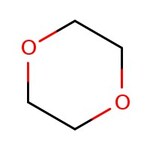Search Thermo Fisher Scientific
1,4-Dioxan, ≥ 99 %, stab. mit ca. 5-10 ppm BHT, Thermo Scientific Chemicals



1,4-Dioxan, ≥ 99 %, stab. mit ca. 5-10 ppm BHT, Thermo Scientific Chemicals
Chemikalien-Kennzeichnungen
Spezifikationen
Beschreibung
This Thermo Scientific Chemicals brand product was originally part of the Alfa Aesar product portfolio. Some documentation and label information may refer to the legacy brand. The original Alfa Aesar product / item code or SKU reference has not changed as a part of the brand transition to Thermo Scientific Chemicals.
1,4-Dioxan wird als Stabilisator für 1,1,1-Trichlorethan und chlorierte Lösungsmittel verwendet. Es dient als Lösungsmittel für Celluloseacetat, Ethylcellulose, Benzylcellulose, Harze, Öle, Wachse, Farbstoffe sowie andere organische und anorganische Verbindungen. Es dient aufgrund seines höheren Siedepunktes und seiner geringeren Toxizität als Ersatz für Tetrahydrofuran. Darüber hinaus wird es als interner Standard für die Protonen-NMR-Spektroskopie in Deuteriumoxid verwendet. Es spielt eine wichtige Rolle bei der Flüssigszintillationszählung in biologischen Verfahren und als Benetzungs- und Dispergiermittel bei der Textilverarbeitung. Es ist an der Vorbereitung von Dimethylmagnesium durch Reaktion mit Methylmagnesiumbromid und an der Vorbereitung histologischer Abschnitte für die mikroskopische Untersuchung beteiligt.
Löslichkeit
Mischbar mit Wasser, organischen Lösungsmitteln, aromatischen Kohlenwasserstoffen und Ölen.
Hinweise
Hygroskopisch. Nicht kompatibel mit Sauerstoff, Oxidationsmitteln, Halogenen, Reduktionsmitteln, Perchloraten und Trimethylaluminium.
Abbildungen
Dokumente und Downloads
Zertifikate
Häufig gestellte Fragen (FAQ)
Zitierungen und Referenzen
Sicherheit und Handhabung
Classification of the substance or mixture
CLP classification - Regulation(EC) No 1272/2008
Label Elements
Signal Word
Danger
Hazard Statements
H319 - Causes serious eye irritation
H335 - May cause respiratory irritation
H350 - May cause cancer
Physical Hazards
H225 - Highly flammable liquid and vapor
EU Specific Hazard Statements
EUH019 - May form explosive peroxides
EUH066 - Repeated exposure may cause skin dryness or cracking
Precautionary Statements
P210 - Keep away from heat, hot surfaces, sparks, open flames and other ignition sources. No smoking
P280 - Wear protective gloves/protective clothing/eye protection/face protection
P303 + P361 + P353 - IF ON SKIN (or hair): Take off immediately all contaminated clothing. Rinse skin with water or shower
P304 + P340 - IF INHALED: Remove person to fresh air and keep comfortable for breathing
P305 + P351 + P338 - IF IN EYES: Rinse cautiously with water for several minutes. Remove contact lenses, if present and easy to do. Continue rinsing
P312 - Call a POISON CENTER or doctor if you feel unwell
Additional EU labelling
Restricted to professional users